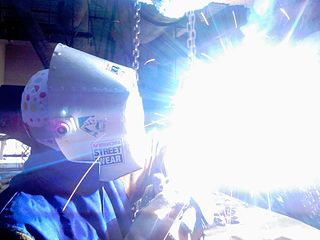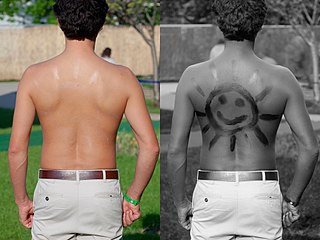
Ultraviolet (UV) is a form of electromagnetic radiation with wavelength from 10 nm to 400 nm, shorter than that of visible light, but longer than X-rays. UV radiation is present in sunlight, and constitutes about 10% of the total electromagnetic radiation output from the Sun. It is also produced by electric arcs and specialized lights, such as mercury-vapor lamps, tanning lamps, and black lights. Although long-wavelength ultraviolet is not considered an ionizing radiation because its photons lack the energy to ionize atoms, it can cause chemical reactions and causes many substances to glow or fluoresce. Consequently, the chemical and biological effects of UV are greater than simple heating effects, and many practical applications of UV radiation derive from its interactions with organic molecules.

Oxybenzone or benzophenone-3 or BP-3 is an organic compound. It is a pale-yellow solid that is readily soluble in most organic solvents. Oxybenzone belongs to the class of aromatic ketones known as benzophenones. It is a naturally occurring chemical found in various flowering plants as well as being an organic component of many sunscreen lotions. It is also in widespread use in things like plastics, toys, furniture finishes, and more to limit UV degradation.

Sunscreen, also known as suncream, sunblock or suntan lotion, is a lotion, spray, gel, foam, stick or other topical product that absorbs or reflects some of the sun's ultraviolet (UV) radiation and thus helps protect against sunburn. Diligent use of sunscreen can also help to slow or temporarily prevent the development of wrinkles, dark spots and sagging skin.

Sun tanning or simply tanning is the process whereby skin color is darkened or tanned. It is most often a result of exposure to ultraviolet (UV) radiation from sunlight or from artificial sources, such as a tanning lamp found in indoor tanning beds. People who deliberately tan their skin by exposure to the sun engage in a passive recreational activity of sun bathing. Some people use chemical products which can produce a tanning effect without exposure to ultraviolet radiation, known as sunless tanning.

Indoor tanning involves using a device that emits ultraviolet radiation to produce a cosmetic tan. Typically found in tanning salons, gyms, spas, hotels, and sporting facilities, and less often in private residences, the most common device is a horizontal tanning bed, also known as a sunbed or solarium. Vertical devices are known as tanning booths or stand-up sunbeds.

Photodermatitis, sometimes referred to as sun poisoning or photoallergy, is a form of allergic contact dermatitis in which the allergen must be activated by light to sensitize the allergic response, and to cause a rash or other systemic effects on subsequent exposure. The second and subsequent exposures produce photoallergic skin conditions which are often eczematous. It is distinct from sunburn.
Ultraviolet light therapy or ultraviolet phototherapy is a form of treatment for certain skin disorders including atopic skin disorder and vitiligo when used with psoralen to form the PUVA treatment. It consists of irradiation of the patient with the UVA band of ultraviolet light, usually delivered from a fluorescent bulb specially designed to output this frequency of ultraviolet.
PUVA is an ultraviolet light therapy treatment for skin diseases: eczema, psoriasis, graft-versus-host disease, vitiligo, mycosis fungoides, large plaque parapsoriasis and cutaneous T-cell lymphoma using the sensitizing effects of the drug psoralen. The psoralen is applied or taken orally to sensitize the skin, then the skin is exposed to UVA.

Ensulizole is a common sunscreen agent. In 1999, the United States Food and Drug Administration regulated that the name ensulizole be used on sunscreen labels in the United States. Ensulizole is primarily a UVB protecting agent providing only minimal UVA protection. The scope of UVB is 290 to 340 nanometers whereas the UVA range is 320 to 400 nanometers. For better UVA protection, it must be paired with avobenzone, titanium dioxide, or zinc oxide; outside of the United States it can also be paired with a UV absorber of the Tinosorb or Mexoryl types. Because ensulizole is water-soluble, it has the characteristic of feeling lighter on skin. As such, it is often used in sunscreen lotions or moisturizers whose aesthetic goal is a non-greasy finish. The free acid is poorly soluble in water, so it is only used as its soluble salts.

UV filters are compounds, mixtures, or materials that block or absorb ultraviolet (UV) light. One of the major applications of UV filters is their use as sunscreens to protect skin from sunburn and other sun/UV related damage. After the invention of digital cameras changed the field of photography, UV filters have been used to coat glass discs fitted to camera lenses to protect hardware that is sensitive to UV light.

Octocrylene is an organic compound used as an ingredient in sunscreens and cosmetics. It is an ester formed by the reaction of 3,3-diphenylcyanoacrylate with 2-ethylhexanol. It is a viscous, oily liquid that is clear and colorless.

Octyl salicylate, or 2-ethylhexyl salicylate, is an organic compound used as an ingredient in sunscreens and cosmetics to absorb UVB (ultraviolet) rays from the sun. It is an ester formed by the condensation of salicylic acid with 2-ethylhexanol. It is a colorless oily liquid with a slight floral odor.
A photochromic lens is an optical lens that darkens on exposure to light of sufficiently high frequency, most commonly ultraviolet (UV) radiation. In the absence of activating light, the lenses return to their clear state. Photochromic lenses may be made of glass, polycarbonate, or another plastic. They are principally used in eyeglasses that are dark in bright sunlight, but clear in low ambient light conditions. They darken significantly within about a minute of exposure to bright light and take somewhat longer to clear. A range of clear and dark transmittances is available.

Tanning lamps are the part of a tanning bed, booth or other tanning device which produces ultraviolet light responsible for indoor tanning. There are hundreds of different kinds of tanning lamps most of which can be classified in two basic groups: low pressure and high pressure. Within the industry, it is common to call high-pressure units "bulbs" and low-pressure units "lamps", although there are many exceptions and not everyone follows this example. This is likely due to the size of the unit, rather than the type. Both types require an oxygen free environment inside the lamp.

The Dobson spectrophotometer, also known as Dobsonmeter, Dobson spectrometer, or just Dobson is one of the earliest instruments used to measure atmospheric ozone.
Helioplex is a formulation of broad-spectrum ultraviolet skin protection containing avobenzone and oxybenzone made by Neutrogena.

Sulisobenzone (benzophenone-4) is an ingredient in some sunscreens which protects the skin from damage by UVB and UVA ultraviolet light.

| C44H59N7O5 |- | Molar mass | 765.981 |- |Section7= }} Iscotrizinol (USAN, INCI diethylhexyl butamido triazone) is an organic compound used in sunscreens to absorb UVB and some UVA radiation with a peak protection at 310nm. It is one of the most photostable chemical sunscreens known today with 25 hours required to lose 10% of its SPF protection ability. It is marketed as Uvasorb HEB by 3V Sigma.
Photoaging or photoageing is a term used for the characteristic changes to skin induced by chronic UVA and UVB exposure. Tretinoin is the best studied retinoid in the treatment of photoaging

Benzphenone-1 – benzophenone-12 are UVA/UVB absorbers. Some of them are used in sunscreens.















